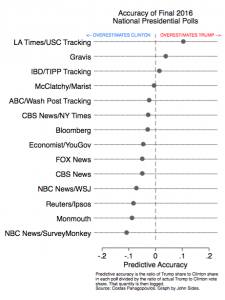It can be argued that in 2008, President-elect Obama’s victory included a significant element of luck, including the timing of the economic meltdown and John McCain’s disastrous veep pick. So too, it can be argued that Trump’s Electoral College win/popular vote loss in 2016 threaded a lucky path through the rust belt.
President Obama did a good job of making the most of his short-lived congressional majorities and produced one historic reform, the Affordable Care Act, which provided health security for additional millions of Americans, and he was able to enact a few other well-received legislative accomplishments, including the Lilly Ledbetter Fair Pay Act. Looking forward to Trump’s presidency and his congressional majorities, it’s hard to see any positive reforms on the horizon. So far all of the Republican talk, and all of Trump’s appointments, have been about undoing Obama’s legislative accomplishments, as if that alone was somehow a great achievement.
Despite Trump’s bloated reputation as a “builder,” no one expects him to actually build much, since he is now waffling on the infrastructure upgrades. No one in GOP Land can identify any concrete plans to better prepare Americans for a new era of prosperity. There are no job-training measures in the Republican legislative hopper, for example, no projects or proposals for innovation that anyone can get excited about.
Instead, it’s all about, “boy, we can’t wait to undo Obama’s reforms.” Trump and the Republicans can only milk that tired cow for so long, before their voters start wondering, like Peggy Lee, “Is that all there is?” At that point, Trump and his fellow Republicans become an awfully inviting target for disgruntled voters who expected something…more.
At slate.com Jamelle Bouie points out that Trump and the GOP are not really in good shape to weather such growing doubts, despite all of the pundit crowing about Republican strength in the House and state houses. As Bouie writes,
…Neither Trump nor congressional Republicans are as strong as they appear. Both enter the field with severe disadvantages, and both risk overplaying the hands that they have. Democrats are on the defensive, but the conditions are there for pushback and resurgence.
Consider Trump’s favorability rating. On Election Day, just 38 percent of Americans had a positive view of Trump, against 60 percent with a negative view. Now, with the glow of victory, his average favorable rating stands at 43 percent, while 49 percent view him unfavorably. For comparison’s sake, Barack Obama entered office in 2009 with a 68 percent favorable rating versus 21 percent unfavorable, while George W. Bush—the victor in a contentious election decided by the Electoral College—entered office with a 50 percent favorable rating. Trump is historically unpopular for an incoming president and shows no signs of improving. This, coupled with his substantial loss in the national popular vote, is a potent vulnerability. Democrats can credibly say that Trump lacks the “will of the people.” They can rebuff charges of obstructionism, and they can say, with little exaggeration, that the public is on their side.
To Trump’s personal unpopularity, you have to add the unpopularity of the Republican policy agenda. Citing Trump’s win as a victory for conservative governance, House Speaker Paul Ryan and the Republican majority are prepping a sweeping small-government agenda, including tax cuts and repeal of the Affordable Care Act. But there’s a problem. The 2016 election wasn’t fought over policy; it was a battle over values and priorities (it’s likely Hillary Clinton made a fatal strategic mistake in not making this a fight over policy). And throughout, Trump showed little interest in conservative policymaking or conservative ideas. He promised help for his supporters and “better deals” for the country, not a Ryan-esque agenda of lower spending and upper-income tax cuts. That agenda is hugely unpopular: Substantial majorities support greater taxes on high-earners, while a smaller majority backs a more active government role in reducing income inequality. And although Americans still disagree about the Affordable Care Act, most of them still reject repeal.
Intoxicated and emboldened by their near-miraculous victory, Republicans are rushing into the new year with a divisive and unpopular agenda, led by a divisive and unpopular president. Indeed, with no apparent plans for increasing manufacturing jobs or improving veterans’ health care, Trump shows few signs of delivering on his substantive promises. In all likelihood, he’ll offer rhetoric and scapegoats and stunts, while delivering little in the way of tangible gains. And all of this will exist against a backdrop of corruption and influence-peddling, as Trump refuses to disentangle himself or his children from their opaque and sprawling web of business interests.
Ultimately, good government has to be about something more than shrinking itself. Ronald Reagan was as eloquent a messenger for tax and budget cuts as the Republicans have ever had. Trump does not have his skill-set, and can only offer a much cruder politics of distraction that is not likely to play well for very long. He can’t count on his November luck hanging around.
The thing about smaller government, budget cuts and austerity is that they are not very inspiring. There is no stirring vision, no uplifting challenge you can hang on shrunken government. FDR, JFK and Obama, were able to generate excitement because they could talk about mobilizing American resources, human and economic, in service to a new era of broadly-shared progress. That message option is not available to Trump, Ryan and McConnell. But I can hear Elizabeth Warren, Sherrod Brown, Cory Booker, Bernie Sanders and maybe a half-dozen other Democrats working it well enough.
In 2016, Democrats lacked the message discipline needed to hold the white house and make substantial gains in congress and the states. By the end of 2017, it should be crystal clear which party has no vision whatsoever for moving America forward.




